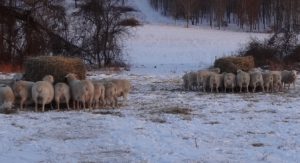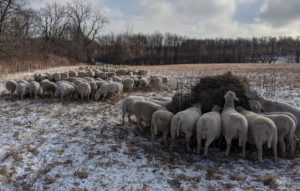Docking Sheep Tails
Is docking sheep tails always necessary?
Docking a sheep’s tail is the common practice of shortening the length of the tail. For practical reasons it is done to avoid fly strike and to reduce fecal soiling. Fly strike occurs when blow flies lay their eggs in soiled and wet wool, mostly around a soiled and moist rear end of a sheep, The emerging larvae (maggots) can cause health problems, including death.
There is another reason to shorten a lamb’s tail or even taking the tail off entirely, which is to have the appearance of a larger and meatier rump. That practice is very common in the show ring although some states have regulated tail docking and require some remainder of the tail left intact.
The most common way of docking tails is by using an elastic and expandable latex ring. The rubber ring is being expanded with an elastrator and put over the tail, where it is released. The ring will then cut off the blood supply to the tail and it will fall off after a number of days.

The docked tails are still long enough to be fully functional.
Ulf Kintzel / White Clover Sheep Farm
The importance of docking tails in wool sheep can be high, depending on breed and geographical location. Fine-wooled sheep are at higher risk of flystrike. It is a very common occurrence in Australia, where death because of maggots is a high risk. In some areas the risk is not as high since not all maggots of blow flies – of which there are more than 1,200 species – attack healthy flesh. Some feed off decomposing matter only and cause more discomfort rather than health problems. Sheep with less wool and with courser wool tend to dry out easier and offer less of a breeding ground for fly larvae. Yet, they can still just as easily get soiled, especially during springtime when the pasture lacks fiber and the sheep’s feces turn very soft or even liquid.
I have practiced tail docking for about 30 years. When I did, I always left the tails long enough to still have the full function of a tail. The tails always covered what need to be protected from sunburn and frost bite – anus and vagina – and it was left long enough to move flies away from that area by wiggling the tail. I highly recommend leaving such tail length in sheep or areas where tail docking is prudent to do. Also, tail docking causes a certain amount of pain to a lamb. For that reason, I docked tails during the first day or two of a lamb’s life when it causes the least amount of pain. Lastly, tail docking has been linked to an increased risk of anal prolapse.
In 2005 I started upgrading my Texel flock with White Dorper rams. Several years later I had a flock of purebred White Dorper sheep since it takes only four generations to get to a purebred flock of a new breed. I had heard from other sheep farmers, who have various kinds of hair sheep, that they do not dock tails. I was both skeptical and curious how that would work. In 2014 I started to forego docking the tails on my replacement ewe lambs, which I had already practiced for many years with my market lambs. A year later in the spring, these sheep, now yearlings, did not have more soiled spots than the ones that were docked. The wool or hair was just too short for feces to accumulate to a degree that it would have become a health problem. In addition, once the sheep started shedding sometime in May, all soiled hair and wool was shed with it, including the ones on the tails.

A more recent picture of my ewes, almost all with long tails.
Ulf Kintzel / White Clover Sheep Farm
I concluded that tail docking is not necessary in my flock of White Dorper sheep, and I don’t dock tails on any lambs anymore. There are few exceptions. For instance, a young ewe may go overboard at times when it cleans her lambs right after it gave birth to them and may nibble parts of the tail away. To avoid an infection, I dock such a tail.
Because I no longer need to dock tails, I save some money (although the latex rubber rings are quite cheap and not much money is being saved), spare myself the work, and spare my lambs some pain. It does trigger the occasional question by someone who has not seen sheep with long tails yet. However, I have not experienced a downside to foregoing this old practice.

